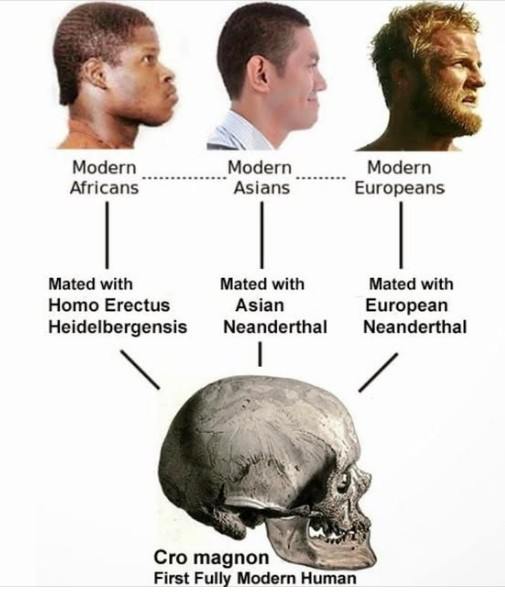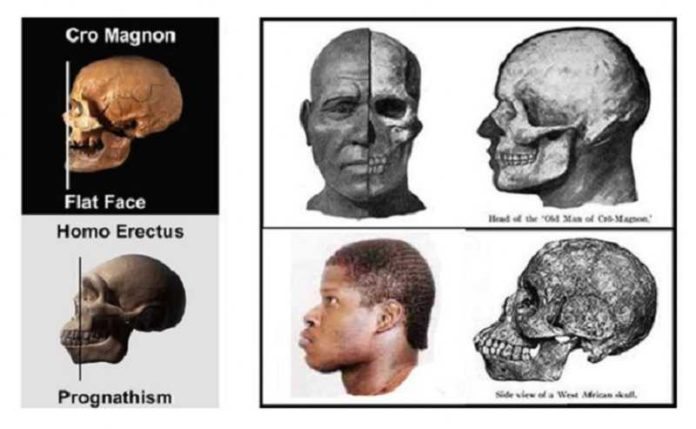Unraveling the Genetic Legacy of Cro-Magnon: Are Modern Europeans Their Direct Descendants?

Introduction to Cro-Magnon and Modern European Genetics
The study of ancient human populations offers a fascinating glimpse into our evolutionary history. Among the most intriguing subjects is the Cro-Magnon, early modern humans who lived approximately 28,000 years ago in Europe. Recent claims suggest that DNA extracted from a Cro-Magnon individual found in the Paglicci cave in Italy is identical to that of modern Europeans, implying no significant genetic changes over millennia. This assertion, supported by studies like Caramelli et al. (2008), raises profound questions about human evolution, genetic continuity, and the origins of European populations. Additionally, controversial claims challenge the widely accepted “Out of Africa” theory, proposing that certain European haplogroups do not descend from African lineages. This article explores these claims, delving into the genetic, anthropological, and historical evidence to assess their validity and implications.

Who Were the Cro-Magnons?
Cro-Magnons are considered the earliest modern humans (Homo sapiens) in Europe, dating back to the Upper Paleolithic period, approximately 40,000 to 10,000 years ago. Named after the Cro-Magnon rock shelter in France where their remains were first discovered, these individuals were anatomically modern, with physical traits closely resembling those of contemporary humans. They were skilled hunters, artists, and toolmakers, leaving behind intricate cave art and sophisticated tools that demonstrate their cognitive abilities.
One of the most striking claims about Cro-Magnons is their alleged larger brain capacity compared to modern humans. Studies suggest their cranial capacity averaged around 1,600 cm³, slightly larger than the modern human average of 1,350 cm³. This difference has sparked debates about whether Cro-Magnons possessed superior cognitive abilities or if brain size differences are negligible in terms of intelligence. Regardless, their genetic makeup is a critical piece of the puzzle in understanding their relationship to modern Europeans.
The Paglicci Cave Discovery: A Genetic Window into the Past
In 2003, researchers uncovered skeletal remains in the Paglicci cave in southern Italy, dated to approximately 28,000 years ago. These remains provided a rare opportunity to analyze ancient DNA, offering insights into the genetic profile of Cro-Magnons. According to Caramelli et al. (2008), the mitochondrial DNA (mtDNA) extracted from the Paglicci individual belonged to the haplogroup H, a common lineage among modern Europeans. This finding suggests a remarkable degree of genetic continuity between Cro-Magnons and present-day European populations.

The claim that the DNA of this Cro-Magnon individual is “identical” to that of modern Europeans requires careful scrutiny. Mitochondrial DNA, which is passed maternally, represents only a small fraction of an individual’s genetic makeup. While the presence of haplogroup H in both Cro-Magnons and modern Europeans indicates a shared maternal lineage, it does not mean the entire genome is identical. Nuclear DNA, which provides a more comprehensive picture, is often degraded in ancient remains, making full genomic comparisons challenging. Nonetheless, the mtDNA evidence supports the idea that Cro-Magnons are direct ancestors of modern Europeans, with minimal genetic drift in certain lineages over thousands of years.
Genetic Continuity: How Stable Are European Genes?
The notion that no significant genetic change has occurred in 28,000 years is both intriguing and controversial. Genetic continuity implies that the core genetic makeup of European populations has remained stable despite millennia of environmental changes, migrations, and interbreeding with other groups, such as Neanderthals. Studies estimate that modern Europeans carry 1-2% Neanderthal DNA, a legacy of interbreeding with Neanderthals who coexisted with Cro-Magnons in Europe. This admixture suggests some genetic change, albeit limited, since the time of the Cro-Magnons.

The stability of haplogroup H in European populations is a key piece of evidence. Haplogroup H is the most common mtDNA haplogroup in Europe today, found in approximately 40-50% of individuals. Its presence in the Paglicci remains indicates that this lineage has persisted for tens of thousands of years. However, genetic continuity does not imply complete stasis. Mutations, genetic drift, and gene flow from neighboring populations have shaped the European gene pool over time. For example, the arrival of Neolithic farmers from the Near East around 8,000 years ago introduced new genetic markers, such as haplogroups J and T, into Europe. These migrations added complexity to the genetic landscape, but the core lineages from Cro-Magnons appear to have endured.
Challenging the “Out of Africa” Theory
The “Out of Africa” theory is a cornerstone of modern anthropology, positing that all modern humans (Homo sapiens) originated in Africa approximately 200,000-300,000 years ago before migrating to other continents. This model is supported by extensive genetic, fossil, and archaeological evidence, including the presence of African haplogroups A and B in early human populations. However, some researchers, such as Klyosov and Rozhanski (2012), challenge this narrative, arguing that certain European haplogroups (e.g., M14, P262, M32, M59) do not descend from African lineages.

Klyosov and Rozhanski’s work is controversial and not widely accepted within the scientific community. Their study, published in a non-mainstream journal, suggests that European haplogroups form a distinct genetic cluster, separate from African lineages. They argue that these haplogroups, associated with populations referred to as “Caucasoids” or “Europeoids,” indicate a unique evolutionary trajectory for Europeans. Critics, however, point out that the methodology and interpretations in this study are flawed, relying on selective data and ignoring the broader genetic evidence supporting African origins.
Mainstream genetic studies, such as those by Reich (2018) and Stringer (2016), reaffirm the “Out of Africa” model. Mitochondrial and Y-chromosome DNA analyses show that all non-African populations share a common ancestor with African populations, with divergence occurring around 60,000-80,000 years ago. The European haplogroups cited by Klyosov and Rozhanski are likely derived from earlier African lineages, with mutations accumulating over time as populations adapted to new environments. The claim of a non-African origin for Europeans lacks robust evidence and contradicts the consensus built on decades of research.
Larger Brain Capacity: Fact or Fiction?
The assertion that Cro-Magnons had a larger brain capacity than modern humans is grounded in anatomical evidence. Fossil records indicate that Cro-Magnon skulls had a cranial capacity of around 1,600 cm³, compared to the modern average of 1,350 cm³. This difference has fueled speculation about their cognitive abilities, with some suggesting that Cro-Magnons were intellectually superior to modern humans.
However, brain size is not a direct indicator of intelligence. Modern neuroscience emphasizes that cognitive capacity depends on factors such as neural efficiency, connectivity, and plasticity, rather than raw size. The reduction in brain size over time may reflect evolutionary adaptations, such as increased energy efficiency or changes in diet and lifestyle. For example, the transition from hunter-gatherer societies to agricultural ones may have reduced the need for certain cognitive demands, leading to slight reductions in cranial capacity.
Moreover, Cro-Magnon art, tools, and burial practices demonstrate sophisticated symbolic thinking and cultural complexity, but these traits are not necessarily tied to larger brain size. Modern humans exhibit comparable cognitive abilities, suggesting that the difference in brain size has minimal functional impact. The focus on brain size may distract from the more significant finding: Cro-Magnons were anatomically and behaviorally modern, sharing the same cognitive potential as their descendants.
Implications for European Identity and Ancestry
The genetic link between Cro-Magnons and modern Europeans has profound implications for our understanding of human ancestry. If the Paglicci cave findings are representative, they suggest that European populations have deep roots in the continent, stretching back tens of thousands of years. This continuity underscores the resilience of certain genetic lineages, even in the face of significant historical upheavals, such as the Ice Age, migrations, and cultural shifts.
However, the narrative of genetic distinctiveness proposed by some researchers risks oversimplifying the complex history of human populations. Europeans, like all humans, are the product of multiple waves of migration and interbreeding. The genetic contributions of Neanderthals, Near Eastern farmers, and later steppe pastoralists have all shaped the modern European gene pool. Claims of a unique “Europeoid” identity ignore this diversity and the shared African origins of all Homo sapiens.
Critiquing the Sources: Caramelli vs. Klyosov
The two primary sources cited in the claim—Caramelli et al. (2008) and Klyosov & Rozhanski (2012)—differ significantly in credibility and impact. Caramelli et al. (2008), published in a peer-reviewed journal, provides robust evidence for the presence of haplogroup H in Cro-Magnon remains. Its methodology, involving careful extraction and analysis of ancient DNA, aligns with established scientific standards. This study is widely cited and supports the broader narrative of genetic continuity in Europe.
In contrast, Klyosov and Rozhanski (2012) is a controversial paper published in a non-mainstream outlet. Its claims about the non-African origins of European haplogroups are not supported by the broader scientific community. The study’s reliance on selective haplogroup data and its dismissal of the “Out of Africa” model have been criticized for lacking rigor. When evaluating such claims, it is essential to prioritize peer-reviewed, consensus-driven research over speculative or fringe publications.
The Broader Context: What DNA Tells Us About Human Evolution
The study of Cro-Magnon DNA is part of a larger effort to understand human evolution through genetics. Advances in ancient DNA sequencing have revolutionized anthropology, allowing researchers to trace the movements and interactions of ancient populations. The Paglicci cave findings, for example, contribute to our understanding of how early modern humans colonized Europe and adapted to its diverse environments.
At the same time, genetic studies highlight the interconnectedness of human populations. While Cro-Magnons are direct ancestors of modern Europeans, they are also part of a broader human story that began in Africa. The “Out of Africa” theory, supported by overwhelming evidence, underscores the shared origins of all modern humans. Claims of genetic distinctiveness, such as those proposed by Klyosov and Rozhanski, often reflect ideological biases rather than scientific consensus.
Conclusion: Bridging the Past and Present
The genetic legacy of the Cro-Magnons offers a window into our shared history, revealing both the continuity and diversity of human populations. The Paglicci cave findings, supported by Caramelli et al. (2008), confirm that Cro-Magnons carried genetic markers still present in modern Europeans, highlighting the deep roots of European ancestry. However, claims of complete genetic stasis or a non-African origin for Europeans are not supported by the broader evidence. The “Out of Africa” theory remains the most robust explanation for human origins, grounded in decades of genetic and archaeological research.
As we continue to unravel the mysteries of our past, the Cro-Magnons remind us of our shared humanity and the complex journey that has shaped who we are today. Their story is not one of isolation or superiority but of adaptation, survival, and connection across millennia.